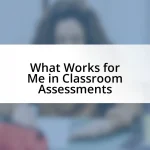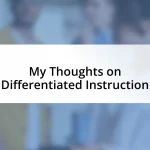Key takeaways:
- Understanding students’ emotional and social needs is crucial for creating a supportive learning environment.
- Building trust through authenticity, active listening, and creating safe spaces fosters openness and connection.
- Using empathy and sharing personal experiences helps students feel valued and understood, enhancing their overall well-being.
- Encouraging student feedback and creating a positive classroom culture leads to more engaged and collaborative learners.

Understanding Student Needs
Understanding student needs goes beyond just academic demands; it taps into their emotional and social realities. I remember a time when a student shared how difficult it was to balance homework with family responsibilities—all while navigating their own personal struggles. In that moment, I realized that successful teaching isn’t just about delivering content; it’s about recognizing and addressing these multifaceted needs.
Have you ever noticed how much a student’s mood can impact their learning? I’ve seen it firsthand when a usually engaged student suddenly becomes withdrawn, only to discover they’re facing challenges at home. Understanding such shifts in behavior allows educators like me to reach out with empathy, helping to create a supportive environment where students feel valued and understood.
Moreover, I often wonder how we can better gauge these needs effectively. Through informal chats, surveys, or even just observing interactions, I find that we can uncover essential insights about what students truly seek in their learning experiences. These small gestures can make a huge difference in building trust and rapport, ultimately enhancing their engagement and success in the classroom.

Building Trust with Students
Establishing trust with students is a cornerstone of effective teaching. I recall an experience where a student confided in me about their struggles with anxiety. Just a simple check-in during a casual conversation helped them open up. That moment taught me how powerful vulnerability can be—trust can blossom when students feel comfortable sharing their challenges without fear of judgment.
To build that trust, I focus on the following key strategies:
– Be Authentic: I strive to show my true self, acknowledging my own struggles and imperfections.
– Listen Actively: When students speak, I make it my priority to listen, demonstrating that their voices matter.
– Be Consistent: I maintain my commitments and follow through on promises, ensuring students know they can rely on me.
– Create Safe Spaces: I cultivate an environment where students feel safe to express themselves freely.
Through these efforts, I’ve seen students gradually lower their walls, revealing layers of their lives I never thought I’d have the privilege to witness. Each connection I forge enriches the learning atmosphere, making it a place where both students and I can thrive together.

Using Empathy in Teaching
Using empathy in teaching transforms the educator-student relationship into something truly collaborative. I remember one particular instance when a student was visibly upset after a poor test score. Instead of merely offering academic advice, I chose to ask her how she felt about it. To my surprise, she opened up about the pressures she faced at home, making that moment not just about academics, but a chance to address her emotional state. I believe that when teachers actively listen and respond with empathy, we help students feel seen, which is essential for their overall well-being.
In my experience, incorporating empathetic practices into my teaching has made a remarkable difference. For example, I often share stories from my own life that relate to the struggles my students face. One day, I shared a personal failure and how it shaped me. This acted as a bridge, helping students realize they are not alone in their challenges. Seeing that spark of recognition in their eyes reassured me that empathy fosters connections we never knew we could have.
Furthermore, I’ve found that tools like journaling or anonymous question boxes allow students to express their feelings without fear. I once implemented an anonymous suggestion box, and the responses were eye-opening. Students shared their fears about the future and the pressure to succeed, which allowed me to tailor my approach. These insights solidified my belief that empathy isn’t just a teaching strategy; it’s a fundamental approach to nurturing a classroom environment where every student can thrive.
| Empathy Strategy | Impact on Students |
|---|---|
| Active Listening | Students feel valued and understood, fostering a safe space for sharing. |
| Sharing Personal Stories | Creates relatability, helping students realize they’re not alone in their struggles. |
| Anonymous Feedback | Encourages honest expression of feelings, guiding teacher responses to student needs. |

Engaging Through Interactive Activities
Engaging students through interactive activities is an incredibly effective way to foster connection and participation. I often find that when students are actively involved in their learning, they’re more willing to engage with the material and with each other. For instance, during a group project, I noticed how excited my students became when they could brainstorm ideas together. Their laughter and chatter filled the room, transforming it from a passive learning environment into a dynamic space where creativity flourished.
One method I love to use is hands-on learning. I remember experimenting with a science lab where students had to create simple circuits. The joy on their faces when the lightbulb lit up was something special. It wasn’t just about completing an assignment; it was a shared moment of discovery, an experience that bonded them with each other and with the subject matter. Have you ever watched students come alive when they’re allowed to explore? It’s one of those magical moments when I realize that authentic learning doesn’t come from lecture notes alone.
Incorporating technology adds another layer of engagement. For example, I’ve used interactive quizzes to assess knowledge in a fun way. One time, a quiz game turned into an all-out competition, where students cheered for their teammates. The atmosphere buzzed with energy as they strategized their answers together. Seeing how much more they retained when learning felt like a game made me reflect on how we can harness this energy and enthusiasm more often in our lessons. When learning is enjoyable, connections become deeper and more meaningful.

Communicating Effectively with Students
Communicating effectively with students is all about building a bridge of understanding. For me, it often starts with simple gestures like making eye contact and using a warm tone. I remember once during a particularly stressful week, I greeted my students with a genuine smile and asked them how they were feeling. The response was overwhelming; they began sharing their worries about upcoming exams and personal events. It struck me then that sometimes, all it takes is an open heart and a few words to make students feel heard.
As an educator, I’ve learned that clarity is just as important as empathy. When presenting complex concepts, I strive to break down ideas into relatable chunks. One memorable moment for me was when I simplified a mathematics problem by connecting it to a situation they all understood—like planning a party. Suddenly, those abstract numbers became relevant and engaging. Have you noticed how students light up when they can relate learning to their own lives? I find it’s those real-life connections that spark interest and make the material unforgettable.
Moreover, I’ve found that varying my communication style keeps students engaged. For example, I often pair verbal instruction with visual aids or even hands-on demonstrations. During one history lesson, I brought in artifacts related to the topic we were discussing. The excitement and curiosity on their faces were contagious. It reinforced for me that effective communication means choosing the right tools and approaches so that every student feels included and inspired to participate. Isn’t it amazing how a few thoughtful adjustments can transform a lesson from mundane to memorable?

Encouraging Student Feedback
Encouraging student feedback can profoundly impact the learning environment. I often make it a habit to check in with my students at the end of each lesson, asking them for their thoughts. One time, after a particularly challenging unit, a student suggested that we include more visual aids to make the concepts clearer. It was enlightening to see how their insights could direct and improve future lessons. Have you ever considered how a simple question might open the door to valuable perspectives?
Creating a safe space for feedback is essential. I typically share my own reflections first to set the tone. In one class, after admitting to mishandling a discussion, I invited students to express their feelings about our communication. The honesty that flowed from them was powerful; they felt empowered to share their experiences without fear of judgment. It reminded me that when students believe their voices matter, they engage more deeply in the process.
Additionally, I try to incorporate anonymous surveys to gather feedback in a less intimidating way. I remember introducing a digital exit ticket where students could share one thing they liked and one thing they wanted to change. The results were eye-opening! Students provided insightful suggestions for improvement that I never would have thought of. This approach not only showed them I valued their opinions, but it also fostered a collaborative classroom culture where everyone feels accountable for each other’s learning. Isn’t it incredible how taking a few moments to ask for feedback can enhance student engagement?

Fostering a Positive Classroom Environment
Fostering a positive classroom environment begins with establishing trust and respect. I remember my first year teaching when I tried an unconventional approach: I invited my students to share their favorite quotes or sayings at the start of the year. This simple activity not only broke the ice, but it also showcased the diverse backgrounds of my students. Have you ever realized how sharing personal experiences can instantly create connections? I saw how those quotes sparked discussions that brought us closer as a group.
Another key element is creating a sense of belonging. I often highlight a “Star of the Week,” a different student each time, allowing them to share their interests or talents with the class. I’ll never forget the day a shy girl revealed her passion for baking and brought in cookies for everyone. The joy on her face—and the way her classmates rallied around her—reminded me how vital these moments are. It’s heartwarming to witness the transformation of students when they feel celebrated and valued. Isn’t it fascinating how small gestures can lead to profound changes in a classroom?
I also find that humor can be a powerful tool in creating a warm atmosphere. During one particularly tense examination period, I decided to lighten the mood with a “funny hat day.” Students wore their silliest hats, and the laughter echoed through the halls. It broke the tension and made everyone feel more relaxed. The moment I saw a student who usually kept to themselves sporting a giant sombrero, I realized we had cultivated a true community—one where students felt safe to express themselves. Don’t you agree that a little laughter can turn stress into connection?














